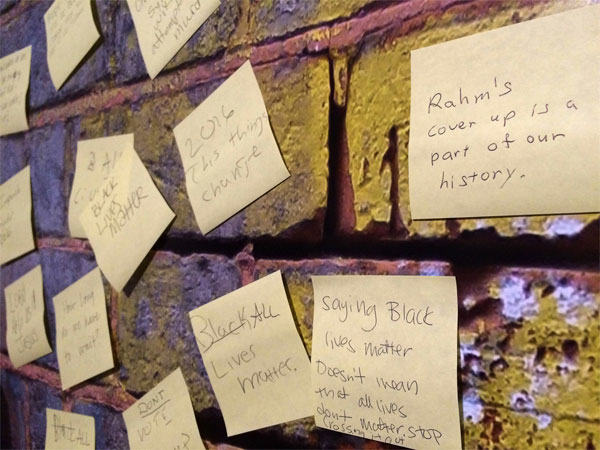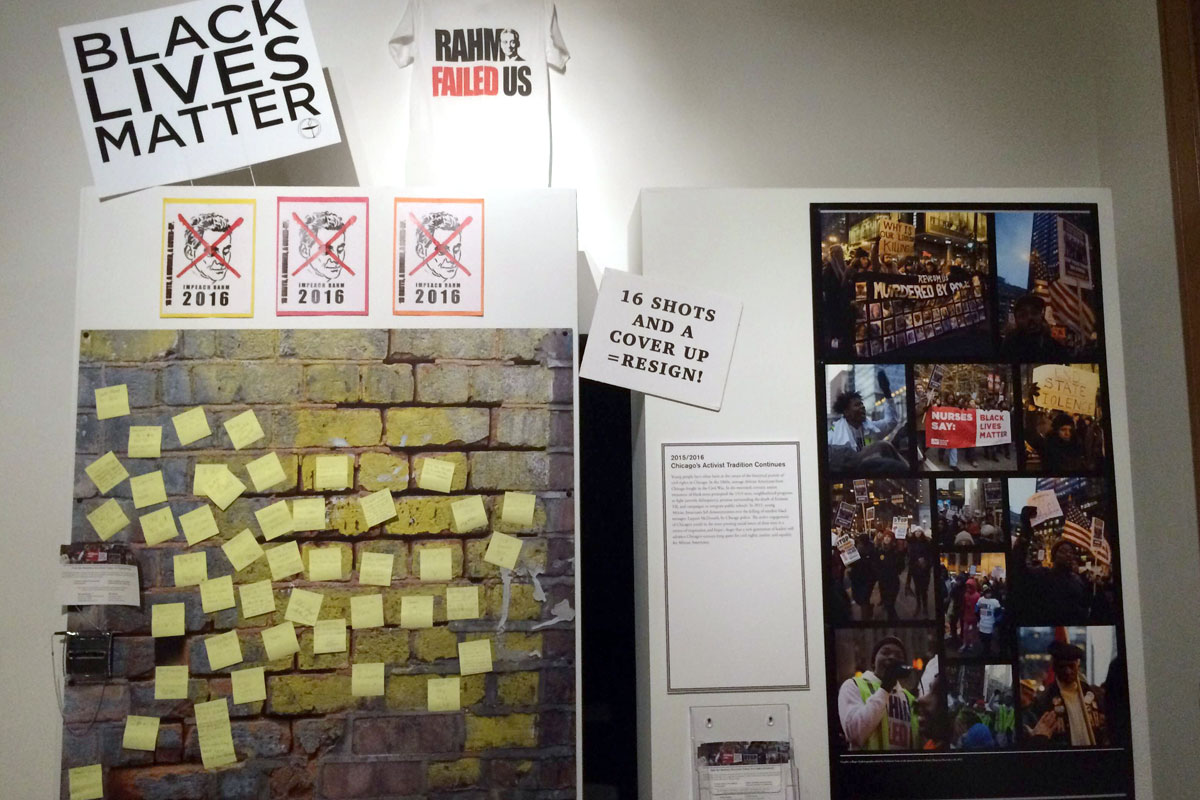On display at the Newberry Library are Post-it notes bearing visitors' messages of support for—and opposition to—today’s civil rights movement. Many read "Black Lives Matter”; on a few, at least one visitor has scratched out “black" and replaced it with "all." Such conflict is welcomed by the library, which hopes to generate discussion through this interactive section of its latest exhibition, "Civil War to Civil Rights: African-American Chicago," which runs through April 2.
Upstairs, Newberry archivists are working on something more permanent. They have called for public submissions to a new collection on today’s civil rights protests—the Black Lives Matter movement in particular—that will be available for future researchers.

I sat down with Newberry staff—digital initiatives librarian Jen Wolfe, curator of modern manuscripts Martha Briggs, communications manager Alex Teller, and curator of Americana Will Hansen—to find out how, exactly, a movement is documented in the modern age.
What spurred the idea of crowdsourcing a modern civil rights archive?
HANSEN: We’d had this exhibit on African American civil rights in Chicago in the works for quite awhile—at least a year—and it was percolating in the back of a number of minds here that the timing was going to be very interesting. The Black Lives Matter movement was ramping up, everything happened in Ferguson, and then this past fall and winter with Laquan McDonald and other protests going on—it seemed like we couldn’t do the exhibit without having some discussion of that.
So I sent a message to our exhibits person, Diane Dillon, saying something like, “I really think we need to have a section around the recent protests in Chicago that explains that this sort of activity is still happening, that civil rights is not something that ends in 1960.”
Have you received many donations so far?
HANSEN: We’re at the stage of having a handful. With these kinds of efforts, it’s not necessarily going to happen automatically. Protests are still going on. People are still using these things. It’s more about putting it in people’s heads that this is a place that they might think about for providing a safe, permanent home for this important historical documentation when it’s time for that.
BRIGGS: When you approach the end of the road, you think about, or your family thinks about: These should be saved; they should be kept somewhere. So even if people don’t give us things right away, they think, “Ah, this kind of stuff is valuable. I should hang onto this; I’m not going to just toss it in the trash.”
Do you think people are keeping that in mind right now?
BRIGGS: I think lots of times when there’s a movement like this, people really get the sense that they’re involved in something important. So I think people do save these kinds of things.
HANSEN: When you think about it in the context of the ’60s civil rights movement, of course we would want to collect the signs that people had on the march to Selma or other iconic events like that. And we’re in the middle of it, so we can’t say how important this phase of the movement is right now, but it seems important to us.
What kinds of artifacts are coming your way?
HANSEN: We had a Black Lives Matter yard sign as one initial artifact. The flyers that are coming look really neat, too. They include, I think, the lyrics for a chant that was done at one of the protests. That kind of thing is really neat to see. Maybe there’s a recording out there somewhere, but if not, that’s going to be the record for what was chanted.
I just got a series from a pretty well-known St. Louis artist named Damon Davis. They're kind of a series of icons of some of the victims of police violence, so those were pretty striking to me.
So much of the Black Lives Matter movement is organized and documented through social media. How do you plan to collect those digital artifacts?
BRIGGS:We’re working on it. We're not there yet, but we will have to get there to be able to collect that side of things. We'll have to see what we get in and if it is stuff that we can digitize and make available as part of our Chicago and Midwest digital collection.
WOLFE: Some institutions are making an effort to collect in this area. At Washington University in St. Louis, they have a Documenting Ferguson site. This sort of grew out of George Mason University’s September 11th archive, collecting things digitally. And these are all crowdsourced: They put a call out and have websites where you can contribute images and videos and tell your stories. A lot of archivists say that this is the future of how we collect history. In the past, we just sort of waited for the documents to show up, but increasingly we have to figure out how to harvest the digital.
What’s your definition of the modern civil rights movement?
HANSEN: I sort of feel like it’s not for me to say.
TELLER: We’re actually having a panel discussion in March featuring young active people in Chicago who are part of this protest movement. And I think that’s going to be one of the things that they kind of grapple with. Are there common goals and strategies that can be articulated? I think from that can come a perspective on answering that question.
Looking back 50 years from now, how do you think researchers will react to this particular collection?
HANSEN: I think people would be surprised if we weren’t trying to collect this sort of thing. They would be disappointed if we weren’t making an effort to collect this history happening around us.
WOLFE: Part of the goal is to collect a more diverse viewpoint.
HANSEN: Diverse in a number of ways. Black perspectives are not as prevalent in our collection as they should be, I think it’s fair to say. And that’s kind of across the board with libraries and archives. We have a lot of white perspectives in our collection and not as many from minority groups. It’s fair to say that in the past, libraries have not been as attuned to working with those groups as they maybe could have or should have been.
What are you hoping that those who may not fully understand today’s protests will learn from the items you’re collecting?
HANSEN: We always think that it's most useful to go to the primary sources of an episode, era, or movement so that we can learn what people were feeling, what they were thinking, what their perspective was on it. So I'm hopeful that this will give people a somewhat direct view of what these protests were like, what sorts of materials were used in them, what people were feeling and thinking about the controversy that they were engaging in. And you know, it's going to be an open collection, so we may get material from the other side, too—the so-called “blue lives matter” or “all lives matter.”
BRIGGS: And we want to. We'd like to. Somebody applies to be a fellow here in 40 years and comes in and looks at the raw material, and they can draw a much better picture of what actually went on from the different sides that we present.
Do you think a collection like this would be as powerful outside of Chicago?
HANSEN: Obviously there's an effort in St. Louis, which is great, and I expect there are other efforts in other cities that have seen large protests, too. Chicago does have a particular history of protest and the need for protest related to racial violence and inequality, so I think certainly that context is important.
BRIGGS: It's the nation's, what, third largest city? It's also one of the most segregated cities. And really, what happens here is kind of a bellwether for what will happen other places.
WOLFE: Its importance is part of the migration north. This was supposed to be a place where people would arrive and everything would be better here. And that’s sadly not the case.




